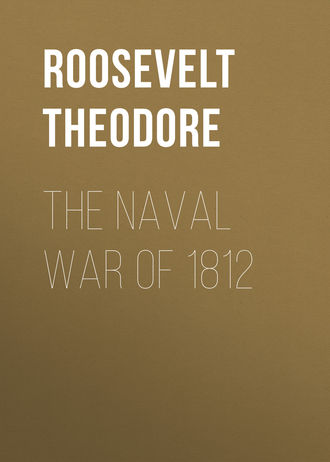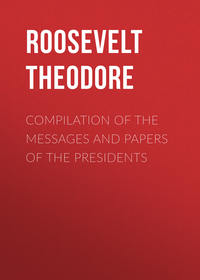 полная версия
полная версияThe Naval War of 1812
As my purpose in giving the tonnage is to get it comparatively, and not absolutely, I have given it throughout for both sides as estimated by the American method of that day. The tonnage of the vessels on the lakes has been already noticed.
Appendix B
PREVIOUS HISTORY OF UNITED STATES NAVYVery few students of naval history will deny that in 1812 the average American ship was superior to the average British ship of the same strength; and that the latter was in turn superior to the average French ship. The explanation given by the victor is in each case the same; the American writer ascribes the success of his nation to "the aptitude of the American character for the sea," and the Briton similarly writes that "the English are inherently better suited for the sea than the French." Race characteristics may have had some little effect between the last pair of combatants (although only a little), and it is possible that they somewhat affected the outcome of the Anglo-American struggle, but they did not form the main cause. This can best be proved by examining the combats of two preceding periods, in which the English, French, and Americans were at war with one another.
During the years 1798-1800, the United States carried on a desultory conflict with France, then at war with England. Our navy was just built, and was rated in the most extraordinary manner; the Chesapeake, carrying 18-pounders, was called a 44; and the Constellation which carried 24's, a 36, while the Washington, rating 24, was really much heavier than the Boston, rating 28. On Feb. 9, 1799, after an hour's conflict, the Constellation captured the French frigate Insurgente; the Americans lost 3, the French 70 men, killed and wounded. The Constitution carried but 38 guns; 28 long 24's, on the main-deck, and 10 long 12's on the quarter-deck, with a crew of 309 men. According to Troude (iii, 169), l'lnsurgente carried 26 long 12's, 10 long 6's, and 4 36-pound carronades; the Americans report her number of men as nearly four hundred. Thus in actual [Footnote: French shot was really very much heavier than the nominally corresponding English shot, as the following table, taken from Captain T. L. Simmon's work on "Heavy Ordnance" (London, 1837, p. 62) will show:
Nominal French Weight Actual Weight of Same Shot in of Shot. English Pounds. 36 lbs. 43 lbs 4 oz. 24 " 28 " 8 3/4" 18 " 21 " 4 1/2" 12 " 14 " 7 " ] (not nominal) weight of shot the Constitution was superior by about 80 pounds, and was inferior in crew by from 50 to 100 men. This would make the vessels apparently nearly equal in force; but of course the long 24's of the Constellation made it impossible that l'lnsurgente, armed only with long 12's, should contend with her. As already said, a superiority in number of men makes very little difference, provided each vessel has ample to handle the guns, repair damages, work the sails, etc. Troude goes more into details than any other French historian; but I think his details are generally wrong. In this case he gives the Constellation 12's, instead of the 24's she really carried; and also supplies her with 10 32-pound carronades—of which species of ordnance there was then not one piece in our navy. The first carronades we ever had were those carried by the same frigate on her next voyage. She had completely changed her armament, having 28 long 18's on the main-deck, ten 24-pound carronades on the quarter-deck; and, I believe, 6 long 12's on the forecastle, with a crew of 310 men. Thus armed, she encountered and fought a drawn battle with la Vengeance. Troude (vol. iii, pp. 201, and 216) describes the armament of the latter as 26 long 18's, 10 long 8's, and 4 36-pound carronades. On board of her was an American prisoner, James Howe, who swore she had 52 guns, and 400 men (see Cooper, i, 306). The French and American accounts thus radically disagree. The point is settled definitely by the report of the British captain Milne, who, in the Seine frigate, captured la Vengeance in the same year, and then reported her armament as being 28 long 18's, 16 long 12's, and 8 36-pound carronades, with 326 men. As the American and British accounts, written entirely independently of one another, tally almost exactly, it is evident that Troude was very greatly mistaken. He blunders very much over the Constellation's armament.
Thus in this action the American frigate fought a draw with an antagonist, nearly as much superior to herself as an American 44 was to a British 38. In November, 1800, the "28-gun frigate," Boston, of 530 tons, 200 men, carrying 24 long 9's on the main-deck, and on the spar-deck 8 long 6's (or possibly 12-pound carronades) captured, after two hours action, the French corvette Berceau, of 24 guns, long 8's; the Boston was about the same size as her foe, with the same number of men, and superior in metal about as ten to nine. She lost 15, and the Berceau 40 men. Troude (iii, p. 219) gives the Berceau 30 guns, 22 long 8's, and 8 12-pound carronades. If this is true she was in reality of equal force with the Boston. But I question if Troude really knew anything about the combatants; he gives the Boston (of the same size and build as the Cyane) 48 guns—a number impossible for her to carry. He continually makes the grossest errors; in this same (the third) volume, for example, he arms a British 50-gun-ship with 72 cannon, giving her a broadside fifty per cent. heavier than it should be (p. 141); and, still worse, states the ordinary complement of a British 32-gun frigate to be 384 men, instead of about 220 (p. 417). He is by no means as trustworthy as James, though less rancorous.
The United States schooner Experiment, of 12 guns, long 6's, and 70 men, captured the French man-of-war three-masted-schooner La Diane, of 14 guns (either 4- or 6-pounders), with a crew of 60 men, and 30 passengers; and the Enterprise, the sister vessel of the Experiment, captured numerous strong privateers. One of them, a much heavier vessel than her captor, made a most obstinate fight. She was the Flambeau brig of fourteen 8-pounders and 100 men, of whom half were killed or wounded. The Enterprise had 3 killed and 7 wounded.
Comparing these different actions, it is evident that the Americans were superior to the French in fighting capacity during the years 1799 and 1800. During the same two years there had been numerous single contests between vessels of Britain and France, ending almost invariably in favor of the former, which I mention first in each couple. The 12-pounder frigate Daedalus captured the 12-pounder frigate Prudente, of equal force. The British 18-pounder frigate Sybille captured the frigate Forte, armed with 52 guns, 30 of them long 24's on the main-deck; she was formidably armed and as heavy as the Constitution. The Sybille lost 22 and the Forte 145 men killed and wounded. The 18-pounder frigate Clyde, with the loss of 5 men, captured the 12-pounder frigate Vestale, which lost 32. The cutter Courser, of twelve 4-pounders and 40 men, captured the privateer Guerrière, of fourteen 4-pounders and 44 men. The cutter Viper, of fourteen 4-pounders and 48 men, captured the privateer Suret, of fourteen 4-pounders and 57 men. The 16-gun ship-sloop, Peterel, with 89 men, engaged the Cerf, 14, Lejoille, 6, and Ligurienne, 16, with in all 240 men, and captured the Ligunenne. The 30-gun corvette Dart captured by surprise the 38-gun frigate Desirée. The Gypsey, of ten 4-pounders and 82 men, captured the Quidproquo, of 8 guns, 4- and 8-pounders, and 98 men. The schooner Milbrook of sixteen 18-pounder carronades and 47 men, fought a draw with the privateer Bellone, of 24 long 8's and six 36-pound carronades. Finally, six months after the Vengeance had escaped from the Constellation (or beaten her off, as the French say) she was captured by the British frigate Seine, which threw a broadside about 30 pounds more than the American did in her action, and had some 29 men less aboard. So that her commander, Captain Milne, with the same force as Commodore Truxtun, of the Constellation, accomplished what the latter failed to do.
Reviewing all these actions, it seems pretty clear that, while the Americans were then undoubtedly much superior to the French, they were still, at least slightly, inferior to the British.
From 1777 to 1782 the state of things was very different. The single combats were too numerous for me to mention them here; and besides it would be impossible to get at the truth without going to a great deal of trouble—the accounts given by Cooper, Sohomberg, and Troude differing so widely that they can often hardly be recognized as treating of the same events. But it is certain that the British were very much superior to the Americans. Some of the American ships behaved most disgracefully, deserting their consorts and fleeing from much smaller foes. Generally the American ship was captured when opposed by an equal force—although there were some brilliant exceptions to this. With the French things were more equal; their frigates were sunk or captured time and again, but nearly as often they sunk or captured their antagonists. Some of the most gallant fights on record are recounted of French frigates of this period; in 1781 the Minerve, 32, resisted the Courageous, 74, till she had lost 73 men and had actually inflicted a loss of 17 men on her gigantic antagonist, and the previous year the Bellepoule, 32, had performed a similar feat with the Nonsuch, 64, while the Capricieuse, 32, had fought for five hours before surrendering to the Prudente and Licorne, each of force equal to herself. She lost 100 men, inflicting a loss of 55 upon her two antagonists. Such instances make us feel rather ashamed when we compare them with the fight in which the British ship Glasgow, 20, beat off an American squadron of 5 ships, including two of equal force to herself, or with the time when the Ariadne, 20, and Ceres, 14, attacked and captured without resistance the Alfred, 20, the latter ship being deserted in the most outrageously cowardly manner by her consort the Raleigh, 32. At that period the average American ship was certainly by no means equal to the average French ship of the same force, and the latter in turn was a little, but only a little, inferior to the average British ship of equal strength.
Thus in 1782 the British stood first in nautical prowess, separated but by a very narrow interval from the French, while the Americans made a bad third. In 1789 the British still stood first, while the Americans had made a great stride forward, coming close on their heels, and the French had fallen far behind into the third place. In 1812 the relative positions of the British and French were unchanged, but the Americans had taken another very decided step in advance, and stood nearly as far ahead of the British as the latter were ahead of the French.
The explanation of these changes is not difficult. In 1782 the American war vessels were in reality privateers; the crews were unpracticed, the officers untrained, and they had none of the traditions and discipline of a regular service. At the same time the French marine was at its highest point; it was commanded by officers of ability and experience, promoted largely for merit, and with crews thoroughly trained, especially in gunnery, by a long course of service on the sea. In courage, and in skill in the management of guns, musketry, etc., they were the full equals of their English antagonists; their slight average inferiority in seamanship may, it is possible, be fairly put down to the difference in race. (It seems certain that, when serving in a neutral vessel, for example, the Englishmen aboard are apt to make better sailors than the Frenchmen.) In 1799 the revolution had deprived the French of all their best officers, had let the character of the marine run down, and the discipline of the service become utterly disorganized; this exposed them to frightful reverses, and these in turn prevented the character of the service from recovering its former tone. Meanwhile the Americans had established for the first time a regular navy, and, as there was excellent material to work with, it at once came up close to the English; constant and arduous service, fine discipline, promotion for merit, and the most unflagging attention to practical seamanship and gunnery had in 1812 raised it far above even the high English standard. During all these three periods the English marine, it must be remembered, did not fall off, but at least kept its position; the French, on the contrary, did fall off, while the American navy advanced by great strides to the first place.
Appendix C
After my work was in press I for the first time came across Prof. J. Russell Soley's "Naval Campaign of 1812," in the "Proceedings of the United States Naval Institute," for October 20, 1881. It is apparently the precursor of a more extended history. Had I known that such a writer as Professor Soley was engaged on a work of this kind I certainly should not have attempted it myself.
In several points our accounts differ. In the action with the Guerrière his diagram differs from mine chiefly in his making the Constitution steer in a more direct line, while I have represented her as shifting her course several times in order to avoid being raked, bringing the wind first on her port and then on her starboard-quarter. My account of the number of the crew of the Guerrière is taken from the Constitution's muster-book (in the Treasury Department at Washington), which contains the names of all the British prisoners received aboard the Constitution after the fight. The various writers used "larboard" and "starboard" with such perfect indifference, in speaking of the closing and the loss of the Guerrière's mizzen-mast, that I hardly knew which account to adopt; it finally seemed to me that the only way to reconcile the conflicting statements was by making the mast act as a rudder, first to keep the ship off the wind until it was dead aft and then to bring her up into it. If this was the case, it deadened her speed, and prevented Dacres from keeping his ship yardarm and yardarm with the foe, though he tried to steady his course with the helm; but, in this view, it rather delayed Hull's raking than helped him. If Professor Soley's account is right, I hardly know what to make of the statement in one of the American accounts that the Constitution "luffed across the enemy's bow," and of Cooper's statement (in Putnam's Magazine) that the Guerrière's bowsprit pressed against the Constitution's "lee or port quarter."
In the action of the Wasp with the Frolic, I have adopted James' statement of the latter's force; Professor Soley follows Captain Jones' letter, which gives the brig three additional guns and 18 pounds more metal in broadside. My reason for following James was that his account of the Frolic's force agrees with the regular armament of her class. Captain Jones gives her two carronades on the topgallant forecastle, which must certainly be a mistake; he makes her chase-guns long 12's, but all the other British brigs carried 6's; he also gives her another gun in broadside, which he calls a 12-pounder, and Lieutenant Biddle (in a letter to his father) a 32-pound carronade. His last gun should perhaps be counted in; I excluded it because the two American officials differed in their account of it, because I did not know through what port it could be fought, and because James asserted that it was dismounted and lashed to the forecastle. The Wasp left port with 138 men; subtracting the pilot and two men who were drowned, makes 135 the number on board during the action. As the battle was fought, I doubt if the loss of the brig's main-yard had much effect on the result; had it been her object to keep on the wind, or had the loss of her after-sails enabled her antagonist to cross her stern (as in the case of the Argus and Pelican), the accident could fairly be said to have had a decided effect upon the contest. But as a short time after the fight began the vessels were running nearly free, and as the Wasp herself was greatly injured aloft at the time, and made no effort to cross her foe's stern, it is difficult to see that it made much difference. The brig's head-sails were all right, and, as she was not close-hauled, the cause of her not being kept more under command was probably purely due to the slaughter on her decks.
Professor Soley represents the combat of the States and Macedonian as a plain yardarm and yardarm action after the first forty minutes. I have followed the English authorities and make it a running fight throughout. If Professor Soley is right, the enormous disparity in loss was due mainly to the infinitely greater accuracy of the American fire; according to my diagram the chief cause was the incompetency of the Macedonian's commander. In one event the difference was mainly in the gunnery of the crews, in the other, it was mainly in the tactical skill of the captains. The question is merely as to how soon Carden, in his headlong, foolishly rash approach, was enabled to close with Decatur. I have represented the closing as taking place later than Professor Soley has done; very possibly I am wrong. Could my work now be rewritten I think I should adopt his diagram of the action of the Macedonian.
But in the action with the Java it seems to me that he is mistaken. He has here followed the British accounts; but they are contradicted by the American authorities, and besides have a very improbable look. When the Constitution came round for the second time, on the port tack, James declares the Java passed directly across her stern, almost touching, but that the British crew, overcome by astonishment or awe, did not fire a shot; and that shortly afterward the manoeuvre was repeated. When this incident is said to have occurred the Java's crew had been hard at work fighting the guns for half an hour, and they continued for an hour and a half afterward; it is impossible to believe that they would have foreborne to fire more than one gun when in such a superb position for inflicting damage. Even had the men been struck with temporary lunacy the officers alone would have fired some of the guns. Moreover, if the courses of the vessels were such as indicated on Professor Soley's diagram the Java would herself have been previously exposed to a terrible raking fire, which was not the case. So the alleged manoeuvres have, per se, a decidedly apocryphal look; and besides they are flatly contradicted by the American accounts which state distinctly that the Java remained to windward in every portion of the fight. On this same tack Professor Soley represents the Java as forereaching on the Constitution; I have reversed this. At this time the Java had been much cut up in her rigging and aloft generally, while the Constitution had set much additional sail, and in consequence the latter forged ahead and wore in the smoke unperceived. When the ships came foul Professor Soley has drawn the Constitution in a position in which she would receive a most destructive stern rake from her antagonist's whole broadside. The positions could not have been as there represented. The Java's bowsprit came foul in the Constitution's mizzen rigging and as the latter forged ahead she pulled the former gradually round till when they separated the ships were in a head and stern line. Commodore Bainbridge, as he particularly says, at once "kept away to avoid being raked," while the loss of the head-sails aboard the Java would cause the latter to come up in the wind, and the two ships would again be running parallel, with the American to leeward. I have already discussed fully the reasons for rejecting in this instance the British report of their own force and loss. This was the last defeat that the British officially reported; the admiralty were smarting with the sting of successive disasters and anxious at all costs to put the best possible face on affairs (as witness Mr. Croker's response to Lord Dundonald's speech in the House). There is every reason for believing that in this case the reports were garbled; exactly as at a later date the official correspondence preceding the terrible disasters at Cabul was tampered with before being put before the public (see McCarthy's "History of our Own Times").
It is difficult to draw a diagram of the action between the Hornet and Peacock, although it was so short, the accounts contradicting one another as to which ship was to windward and which on the "larboard tack;" and I do not know if I have correctly represented the position of the combatants at the close of the engagement. Lieutenant Conner reported the number of men aboard the Hornet fit for duty as 135; Lawrence says she had 8 absent in a prize and 7 too sick to be at quarters. This would make an original complement of 150, and tallies exactly with the number of men left on the Hornet after the action was over, as mentioned by Lawrence in his account of the total number of souls aboard. The log-book of the Hornet just before starting on her cruise, states her entire complement as 158; but 4 of these were sick and left behind. There is still a discrepancy of 4 men, but during the course of the cruise nothing would be more likely than that four men should be gotten rid of, either by sickness, desertion, or dismissal. At any rate the discrepancy is very trivial. In her last cruise, as I have elsewhere said, I have probably overestimated the number of the Hornet's crew; this seems especially likely when it is remembered that toward the close of the war our vessels left port with fewer supernumeraries aboard than earlier in the contest. If such is the case, the Hornet and Penguin were of almost exactly equal force.
My own comments upon the causes of our success, upon the various historians of the war, etc., are so similar to those of Professor Soley, that I almost feel as if I had been guilty of plagiarism; yet I never saw his writings till half an hour ago. But in commenting on the actions of 1812, I think the Professor has laid too much stress on the difference in "dash" between the combatants. The Wasp bore down with perfect confidence to engage an equal foe; and the Hornet could not tell till the Peacock opened fire that the latter was inferior in force, and moreover fought in sight of another hostile vessel. In the action with the Guerrière it was Hull and not Dacres who acted boldly, the Englishman delaying the combat and trying to keep it at long range for some time. In this fight it must be remembered that neither foe knew the exact force of the other until the close work began; then, it is true, Dacres fought most bravely. So with the Macedonian; James particularly says that she did not know the force of her foe, and was confident of victory. The Java, however, must have known that she was to engage a superior force. In neither of the first two frigate actions did the Americans have a chance to display any courage in the actual fighting, the victory was won with such ease. But in each case they entered as bravely, although by no means as rashly or foolishly, into the fight as their antagonists did. It must always be remembered that until this time it was by no means proved that 24-pounders were better guns than 18's to put on frigates; exactly as at a little later date it was vigorously contended that 42-pounders were no more effective guns for two-deckers than 32-pounders were. Till 1812 there had been no experience to justify the theory that the 24-pounder was the better gun. So that in the first five actions it cannot be said that the British showed any especial courage in beginning the fight; it was more properly to be called ignorance. After the fight was once begun they certainly acted very bravely, and, in particular, the desperate nature of the Frolic's defence has never been surpassed.









